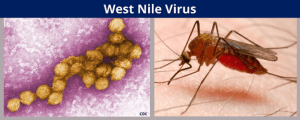TAG: GS 3: SCIENCE AND TECHNOLOGY
THE CONTEXT: The outbreak of West Nile fever in several districts of Kerala has prompted swift action from the state’s health department.
EXPLANATION:
- With confirmed cases reported in multiple regions, authorities are mobilizing efforts to control the spread of the disease through heightened surveillance and mosquito control measures.
- The health department has confirmed cases of West Nile fever in three districts: Kozhikode, Malappuram, and Thrissur.
- In Kozhikode, five vector-borne disease cases were reported, with four individuals having recovered and one currently receiving treatment at a government medical college hospital.
- District officials emphasize that while cases have been reported before, there is no cause for alarm, and the situation is being managed effectively.
Government Response and Directives:
- State Health Minister has issued directives urging all district authorities to remain vigilant and take proactive measures.
- The health department has ordered all districts to intensify mosquito control measures, including pre-monsoon cleaning drives and surveillance activities.
- Authorities emphasize the importance of destroying mosquito breeding grounds to curb transmission.
The West Nile Virus (WNV):
- The West Nile Virus is a mosquito-borne, single-stranded RNA virus.
- According to the WHO, it is “a member of the flavivirus genus and belongs to the Japanese Encephalitis antigenic complex of the family Flaviviridae”.
- Culex species of mosquitoes act as the principal vectors for transmission. It is transmitted by infected mosquitoes between and among humans and animals, including birds, which are the reservoir host of the virus.
- WNV can also spread through blood transfusion, from an infected mother to her child, or through exposure to the virus in laboratories. It is not known to spread by contact with infected humans or animals.
- According to the US Centre for Disease Control and Prevention (CDC), it does not spread “through eating infected animals, including birds. Always follow instructions for fully cooking meat”.
- To date, no human-to-human transmission of WNV through casual contact has been documented, says the WHO.
- The disease is asymptomatic in 80% of the infected people. The rest develop what is called the West Nile fever or severe West Nile disease. In these 20% cases, the symptoms include fever, headache, fatigue, body aches, nausea, rash, and swollen glands.
- The virus was first isolated in a woman in the West Nile district of Uganda in 1937. It was identified in birds (crows and columbiformes like doves and pigeons) in the Nile delta region in 1953. Before 1997, WNV was not considered pathogenic for birds, but then, a more virulent strain caused the death in Israel of different bird species, presenting signs of encephalitis and paralysis.
- In 1999, a WMV strain, believed to be one circulating in Israel and Tunisia, reached New York producing a large outbreak that spread across the United States and eventually across the Americas, from Canada to Venezuela.
- In Kerala, the virus was first detected in 2011, with sporadic cases reported over the years.
- According to the WHO, human infections attributable to WNV have been reported in many countries in the world for over 50 years.
- WNV outbreak sites are found along major bird migratory routes.
- Today, the virus is found commonly in Africa, Europe, the Middle East, North America, and West Asia.


